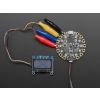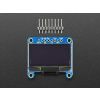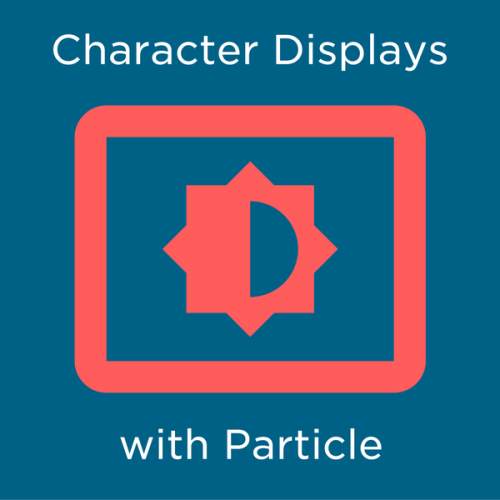Monochrome 1.3" 128x64 OLED graphic display - STEMMA QT / Qwiic
Available with a lead time
Expect dispatch between Jan 06 and Jan 12
Quantity Discounts:
- 10+ $30.25 (exc GST)
- 50+ $29.62 (exc GST)
These displays are small, only about 1.3" diagonal, but very readable due to the high contrast of an OLED display. This display is made of 128x64 individual white OLED pixels, each one is turned on or off by the controller chip. Because the display makes its own light, no backlight is required. This reduces the power required to run the OLED and is why the display has such high contrast; Adafruit really like this miniature display for its crispness!
The driver chip, SSD1306 can communicate in two ways: I2C or SPI. The OLED itself require a 3.3V power supply and 3.3V logic levels for communication, but Adafruit include a 3.3V regulator and all pins are fully level shifted so you can use with 3V or 5V devices!
Adafruit have updated the design to add auto-reset circuitry so that the reset pin is optional. The default interface is now I2C not SPI - since it speaks I2C you can easily connect it up with just two wires (plus power and ground!). Adafruit have even included SparkFun qwiic compatible STEMMA QT connectors for the I2C bus so you don't even need to solder!
The power requirements depend a little on how much of the display is lit but on average the display uses about 40mA from the 3.3V supply. Built into the OLED driver is a simple switch-cap charge pump that turns 3.3v-5v into a high voltage drive for the OLEDs.
Adafruit have a detailed tutorial and example code for Arduino and Python/CircuitPython for text and graphics. You'll need a microcontroller with more than 1K of RAM since the display must be buffered. The library can print text, bitmaps, pixels, rectangles, circles and lines. It uses 1K of RAM since it needs to buffer the entire display but its very fast! The code is simple to adapt to any other microcontroller.
Please note that OLED displays are made of hundreds of...OLEDs! That means each pixel is a little organic LED, and if its kept on for over 1000 hours it'll start to dim. If you want to keep the display uniformly bright, please turn off the display (set the pixels off) when it isn't needed to keep them from dimming.
TECHNICAL DETAILS
Revision History:
- As of Nov 20, 2019 we've done a re-design to make the display more plug and play.There is now an auto-reset circuit so that it will reset the display on power up. We've also changed the default protocol to be I2C instead of SPI. To convert to SPI mode you will need to cut two jumpers (there's a typo on the PCB). We have also added two STEMMA QT / Qwiic connectors for plug and play usage! The board size, mounting holes and layout has changed slightly to accomodate these changes.
Breakout Board Dimensions:
- PCB: 35.6mm x 33mm x 6.2mm / 1.4" x 1.9" x 0.24"
- Mounting Hole Dimensions: 30.5mm x 28mm / 1.2" x 1.1"
- Mounting Hole Diameter: 2.5mm / 0.1"
- Screen: 34.5mm x 23mm / 1.3" x 0.9"
- Weight: 6g
- This board/chip uses I2C 7-bit address between 0x3C-0x3D, selectable with jumpers
OLED Display Details:
- Diagonal Screen Size:1.30"
- Number of Pixels:128 × 64
- Color Depth:Monochrome (White)
- Module Construction:COG
- Module Size (mm):34.50 x 35.00
- Panel Size (mm):34.50 x 23.00 x 1.45
- Display Area (mm):29.420 x 14.70
- Pixel Pitch (mm):0.23 x 0.23
- Pixel Size (mm):0.21 x 0.21
- Weight (g):2.18
- Duty:1/64
- Brightness ( cd/m2):100 (Typ) @ 12V
- Display current draw is completely dependent on your usage: each OLED LED draws current when on so the more pixels you have lit, the more current is used. They tend to draw ~25mA or so in practice but for precise numbers you must measure the current in your usage circuit.
Datasheets, EagleCAD PCB files, Fritzing object and more in the tutorial
Exact shipping can be calculated on the view cart page (no login required).
Products that weigh more than 0.5 KG may cost more than what's shown (for example, test equipment, machines, >500mL liquids, etc).
We deliver Australia-wide with these options (depends on the final destination - you can get a quote on the view cart page):
- $3+ for Stamped Mail (typically 10+ business days, not tracked, only available on selected small items)
- $7+ for Standard Post (typically 6+ business days, tracked)
- $11+ for Express Post (typically 2+ business days, tracked)
- Pickup - Free! Only available to customers who live in the Newcastle region (must order online and only pickup after we email to notify you the order is ready). Orders placed after 2PM may not be ready until the following business day.
Non-metro addresses in WA, NT, SA & TAS can take 2+ days in addition to the above information.
Some batteries (such as LiPo) can't be shipped by Air. During checkout, Express Post and International Methods will not be an option if you have that type of battery in your shopping cart.
International Orders - the following rates are for New Zealand and will vary for other countries:
- $12+ for Pack and Track (3+ days, tracked)
- $16+ for Express International (2-5 days, tracked)
If you order lots of gear, the postage amount will increase based on the weight of your order.
Our physical address (here's a PDF which includes other key business details):
40 Aruma Place
Cardiff
NSW, 2285
Australia
Take a look at our customer service page if you have other questions such as "do we do purchase orders" (yes!) or "are prices GST inclusive" (yes they are!). We're here to help - get in touch with us to talk shop.
Have a product question? We're here to help!
Videos
View AllGuides
How to Rotate Raspberry Pi Video Display / Screen
The Maker Revolution
Character Displays with Particle
Projects
Simple e-ink dashboard
Raspberry Pi Desk Clock with Data Display
grinder_timer
Makers love reviews as much as you do, please follow this link to review the products you have purchased.







![Coin Cell Battery - 20mm (CR2032) [Bulk, Minimum of 5 Units]](https://core-electronics.com.au/media/catalog/product/cache/079b11c976bbe03b0dbfb11acc4eba81/c/o/coin_cell_battery_-_20mm__cr2032___prt-00338__01.jpg)








Product Comments